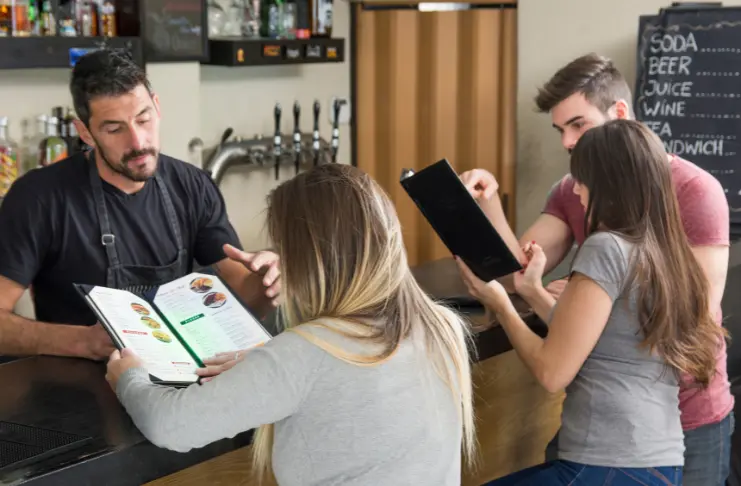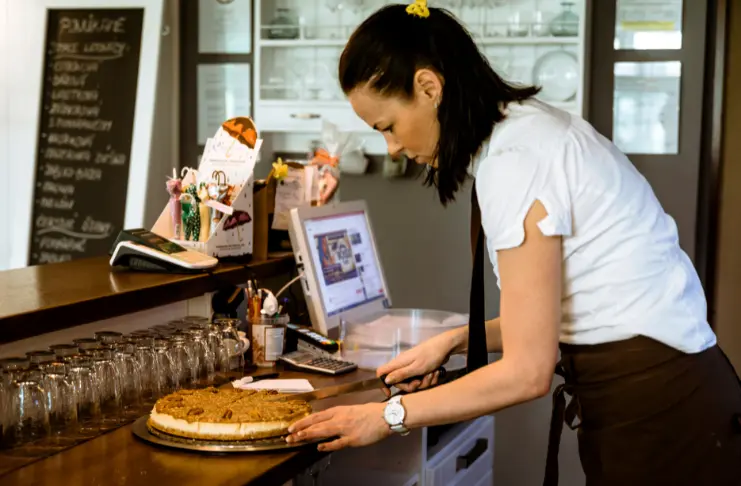
Menus have always been a key operational and revenue element in restaurants. However, today, they are also a reflection of economic shifts, consumer values, and digital influence. Menu strategy is no longer limited to what’s popular or seasonal. Instead, with ingredient costs rising and diners becoming more selective, operators are being forced to rethink how they price, position, and update it.
Across the U.S., price-sensitive guests are seeking better value, while still expecting flexibility, healthier choices, and transparent sourcing. At the same time, digital ordering adds another layer of complexity.
With QR-based menus, loyalty apps, and AI-powered ordering interfaces, restaurants now have the ability—and pressure—to personalize offerings, manage price elasticity, and optimize menus that better align with changing dining trends.
This blog unpacks the latest restaurant menu statistics, including what diners are actually ordering, how much they’re willing to spend, and which pricing strategies are gaining traction.
Restaurant Menu Statistics: Pricing Trends and Factors
A. Rising Menu Prices and Inflation Impact
U.S. restaurants continue to face severe inflation pressures. As of June 2025, the Consumer Price Index (CPI) for food away from home, which includes restaurant meals, has risen 3.8% year-over-year, while menu prices rose 0.4% in June.
Further, looking at menu prices by segment, full-service restaurant prices increased 4.0%, while limited-service (fast food restaurants) prices climbed 3.5% annually.
This price pressure across dine-in and quick-service outlets reflects wider economic stress. From 2019 to 2024, restaurant-related costs, including ingredients, labor, utilities, and swipe fees, increased by 16-32%, forcing restaurant owners to pass a 27.2% menu price increase onto consumers.
B. Key Drivers of Menu Pricing Inflation
Menu prices across the U.S. restaurant industry have risen steadily in 2025, not just due to raw material costs, but because of structural cost increases across key operations.
Here are the primary factors reshaping menu economics-
1. Labor Costs
Labor remains the single largest expense for most restaurants. With ongoing competition for front- and back-of-house roles, average hourly wages have climbed significantly. As of 2024, labor costs have increased by 31% compared to pre-2020 levels, driven by minimum wage hikes in key states, retention bonuses, and increased reliance on training due to higher turnover.
For many operators, this means adjusting menu prices to offset payroll burdens, particularly during peak hours and in high-labor service models, such as full-service dining.

2. Location and Utilities
Energy, rent, and occupancy costs have also escalated post-pandemic. Restaurants report a 12% increase in utility bills from 2019 to 2022. These recurring fixed costs directly influence price-setting strategy, mainly for high-footprint or multi-location operators.
3. Tariffs, Supply Chain, and Volatility
Food input costs are unpredictable due to a combination of international tariffs, climate disruptions, and logistics delays. Tariffs on imported ingredients add an estimated 6-12% to the cost of goods sold (COGS) for many U.S. restaurants because of increased vendor and inventory costs.
Additionally, unpredictable weather patterns and crop shortages have inflated prices of core staples like rice, lettuce, potatoes, and wheat, forcing short-term pricing adjustments and frequent menu changes.
4. Payment Processing Fees
Transaction fees are often overlooked, but increasingly burdensome costs for restaurants. Swipe fees, a fee charged by card networks, have increased by 10% in the past year and are almost three times the fees in 2014.
Such high swipe fees cut into restaurant margins on every customer payment. For digital-heavy models, like QSRs and delivery-first restaurants, the impact is more significant. As a result, some restaurants are introducing service charges or cash discounts to compensate, while others are adjusting their menu prices to account for processing losses.
Restaurant Menu Pricing Strategies
As food costs rise and consumer expectations shift, how restaurants price their menus has become both a science and an art. Operators are moving beyond static markups to adopt more adaptive, insight-driven strategies that reflect customer behavior, market dynamics, and real-time demand.
Here are 7 of the most widely used and effective pricing models in today’s restaurant landscape-
1. Cost-Plus Pricing
This is one of the most traditional methods, where menu prices are based on total production costs, including ingredients, labor, overhead, plus a set markup, often between 25% and 35%.
It is a simple model, ideal for independent operators and quick-service formats that work with predictable costs. For example, if a dish costs $4 to prepare, a 30% food cost percentage would make the menu price $13.
This method ensures that profit margins are built into every dish, but it overlooks customer perception and market competition, which can result in underpricing or missed premium opportunities.
2. Competitive Pricing
Rather than focusing solely on internal costs, competitive pricing involves analyzing what others in the local market are charging for similar items and positioning your prices accordingly. This strategy is especially relevant for high-frequency, commoditized items like burgers, pizzas, or breakfast combos, where customers are more likely to compare options.
While it helps maintain market relevance, it can be limiting for restaurants that offer higher-quality or differentiated experiences.
3. Psychological Pricing
Psychological pricing relies on human perception to influence purchasing decisions. One common tactic is charm pricing, which involves setting prices just below a round number (e.g., $9.99 instead of $10). This way, customers tend to perceive it as significantly cheaper.
Another technique is anchoring: placing a high-priced item next to a mid-tier option to make the latter appear more reasonably priced. For example, a $26 steak entrée might be placed next to a $38 ribeye, increasing conversions on the lower-priced item.
Fast food and fast casual brands have long used psychological pricing to boost conversion rates and increase average ticket size.
4. Value-Based Pricing
This model sets prices based on how much a customer is willing to pay for the experience or product, rather than its raw cost. It’s especially effective for restaurants offering something unique, such as sustainably sourced ingredients, dietary customization, or exceptional ambiance.
For example, a $17 salad bowl may seem steep if evaluated strictly by ingredient cost, but customers may justify it for its health benefits, ethical sourcing, or Instagram-worthy presentation.

5. Dynamic Pricing
This approach adjusts menu prices based on external factors such as demand, time of day, weather, or traffic flow. Similar to airline or ride-share models, it allows restaurants to optimize pricing during peak hours and offer deals during slow hours.
Wendy’s announced plans to pilot digital menus that shift pricing dynamically, raising the cost of items during busier hours. While still in early stages for most of the industry, dynamic pricing offers a glimpse into a more flexible, data-responsive future.
6. Menu Engineering
Menu engineering combines psychology, layout, and profit analysis to strategically position dishes. Items are categorized as Stars (high profit, high popularity), Puzzles (high profit, low popularity), Plow-horses (popular but low profit), or Dogs (low profit and low popularity).
Restaurants use data from their POS system to redesign menus, highlighting star items with bold text or premium placement while downplaying or modifying underperformers. This technique can meaningfully impact purchasing behavior and revenue.
7. Premium Pricing
In fine dining or niche formats, higher pricing is part of the brand. Premium pricing intentionally places dishes at the top end of the scale to reinforce exclusivity, quality, and value perception.
A $26 entrée in a white-tablecloth setting is priced to reflect the chef’s expertise, sourcing, and customer experience. This strategy works best when the product and ambiance clearly justify the price, and the target audience expects to pay more. It’s also being used by fast-casuals offering limited-run, high-quality items, such as single-origin coffee.
Most Popular Menu Items and Categories in Restaurants
A. Chicken
- 47% of U.S. restaurant menus now feature fried chicken sandwiches, surpassing hamburgers (41%).
- Chicken-based items, including sandwiches, tenders, wings, nuggets, etc., have increased 6.4% over five years, compared to a 4.7% rise for beef items.
- Quick-service restaurants (QSRs) saw an 11% increase in chicken product consumption (sandwiches, wings, nuggets) since 2019, with a 2% gain in the year ending October 2024.
- A 2025 Yelp report highlights a 125% rise in “chicken sandwich” searches from June 2019 to June 2025, showing growing diner interest.
- Chick-fil-A remains the top-rated chain for chicken sandwiches according to Yelp, with other chains like Dave’s Hot Chicken and Raising Cane’s quickly rising in popularity.
B. Plant-Based Items
- Nearly 50% of U.S. restaurants now offer plant‑based options, highlighting a jump of 62% over recent years.
- Plant-based dairy, especially oat milk and alternative cheeses, has seen 400% menu penetration growth in recent years.
- In 2023, 6% of restaurant customers ordered a menu item featuring plant-based protein, up from 1.9% in 2022.
- Roughly 6.5% of the top 500 chain restaurants included plant-based proteins in salads or main dishes in 2023.
- Among restaurants surveyed in 2023, 64.7% of fast-casual operators and 48.4% of all restaurants offered plant-based menu items.
C. Comfort Food
- The National Restaurant Association’s “What’s Hot” forecast ranks world‑stage soups and stews (e.g., birria, tom kha, ramen) and grilled/cooked cheeses among the Top 10 trends for 2024-25, reflecting a preference for comfort food in restaurant menus.
- Fried chicken appears on 45% of full-service restaurant menus and 50% of limited-service menus, making it one of the most prevalent comfort offerings listed by culinary professionals.
- Consumers frequently order comfort dishes not just to eat, but to connect: 40% say they choose comfort food to satisfy cravings, 34% as a simple meal, and 25% to socialize, underscoring its emotional and social appeal.
- Technomic’s Comfort Foods Consumer Study reports that 47% of consumers identify meatloaf or casseroles, and 20% list mashed potatoes, as definitive comfort food dishes.

D. Desserts and Pastries
- Dessert prices at restaurants rose by 3.2% between 2023 and 2024, leading to fewer customers ordering sweets. In fast-casual restaurants, dessert menu visibility has declined.
- Premium dessert items sales account for approximately 35% of the total dessert market, demonstrating high margins and guest appeal via tableside or plated offerings.
- Gourmet doughnuts and pastry hybrids (like cruffins and croffles) are growing at a projected 8% annual rate in food-service channels, reflecting consumer desire for unique desserts.
- Vanilla ice cream accounted for 27% of all dessert orders in summer 2024, while chocolate-pistachio orders rose 35% year-over-year.
Evolving Customer Preferences in Restaurant Menus
Today’s guests expect more from restaurant menus than they did even a few years ago. They want taste, yes—but they also look for value, personalization, and fulfilling experiences. Below are the major trends and consumer preferences reshaping menus-
1. Healthy Menus
While not everyone dines for wellness, a large and growing segment expects healthier menu options in restaurant menus. Nearly 60% of consumers consider sustainability an important factor when choosing a restaurant.
As a result, 45% of chefs and operators now prioritize locally sourced ingredients in their menu, while the use of plant-based ingredients in restaurant menus grew by approximately 23% from 2019 to 2022.
2. Balance Between Value and Affordability
Owing to growing inflation, diners today are seeking cheaper food. But they also expect quality and value in equal measure. Yelp data reveals searches for “value meal” increased 22% and “cheap eats” rose 21% year-over-year in early 2025, indicating a strong interest in affordable, satisfying menus that are also seen as worthwhile.
Rather than slashing prices, restaurant operators are launching tiered bundles or value add-ons to encourage more engagement and restaurant sales.
3. Customizable and Flexible Menus
One-size-fits-all menus are no longer viable when customer expectations change every day. Diners increasingly expect the choice to customize their order, from swapping side dishes and choosing cooking styles to adapting meals to fit allergies or dietary needs.
In fact, about 55% of consumers prefer restaurants offering allergen-friendly or dietary‑flexible menu options. So, offering build-your-own bowls, mix-and-match sides, and allergen-friendly choices in the menu is an excellent way to boost guest satisfaction and increase average spend through add-ons like extra toppings and protein upgrades.

4. Global Flavors
Diners in 2025 are looking for global tastes and culinary discovery through fusion menus. According to industry research, 43% of diners now actively want globally inspired dishes when eating out, marking a meaningful shift in what they expect from menu innovation.
Restaurant menus are seeing growing demand for items from international cuisines, like Korean BBQ tacos, Mediterranean grain bowls, or Thai main courses. Data also supports this trend: 87% of Gen Z diners want to see more international flavors in chain restaurants.
In fact, these globally inspired items help boost check sizes for restaurants. Limited-time international specials or “chef’s global picks” often come with a slightly higher price point, and diners are willing to pay more for the novelty.
5. Digital Convenience and Off‑Premise Menus
As off-premise dining becomes the norm, restaurant menus are adapting to meet digital-first expectations. The National Restaurant Association reveals that nearly 75% of all restaurant traffic now happens offline, from drive-thru, takeout, or delivery orders.
With this shift, menus are evolving. Restaurants now design menus specifically for digital interfaces, such as app screens, QR codes, and third-party platforms, to make ordering quick and intuitive.
EXPERT OPINION
Dr. Chad Moutray, VP of research and knowledge for the National Restaurant Association, says, “This year’s forecast highlights a powerful shift toward enhancing both individual wellness and the health of our planet. As customers seek sustainable choices and exciting new flavor experiences, restaurants are responding with options that emphasize locally sourced ingredients and innovative menu offerings. The popularity of Southeast Asian flavors also speaks to a more adventurous consumer palate, with many diners interested in global cuisine that brings added depth to their dining experiences.” |
Conclusion
A well-designed menu today is a reflection of how well a restaurant understands its guests. As dining habits shift, menus are quietly becoming one of the most powerful tools for staying relevant and retaining customers. The more operators observe what’s being chosen, skipped, or customized, the better they can fine-tune pricing, portions, and the entire dining experience.
Frequently Asked Questions
Most restaurants use a static menu, which features a consistent list of dishes that rarely change. This format ensures operational efficiency and helps with inventory planning. It’s especially common in casual dining, quick service, and chain restaurants.
In the restaurant industry, the 4 P’s are- Product, Price, Place, and Promotion, which form the foundation of strategic planning. They cover what’s served and how it’s delivered, how much it costs, where the business operates, and the methods used to reach customers.
Pizza is among the most profitable dishes in a restaurant due to low ingredient costs, simple preparation, and high perceived value. Other high-margin items include pasta, omelets, soups, and alcoholic beverages, all of which combine low overhead with strong customer appeal and markup potential.
The top reasons restaurants fail include poor financial management, especially underestimating costs and overestimating revenue. Inconsistent cash flow, lack of budgeting, and inadequate pricing strategies often lead to early closures, even when food and service quality are strong.








